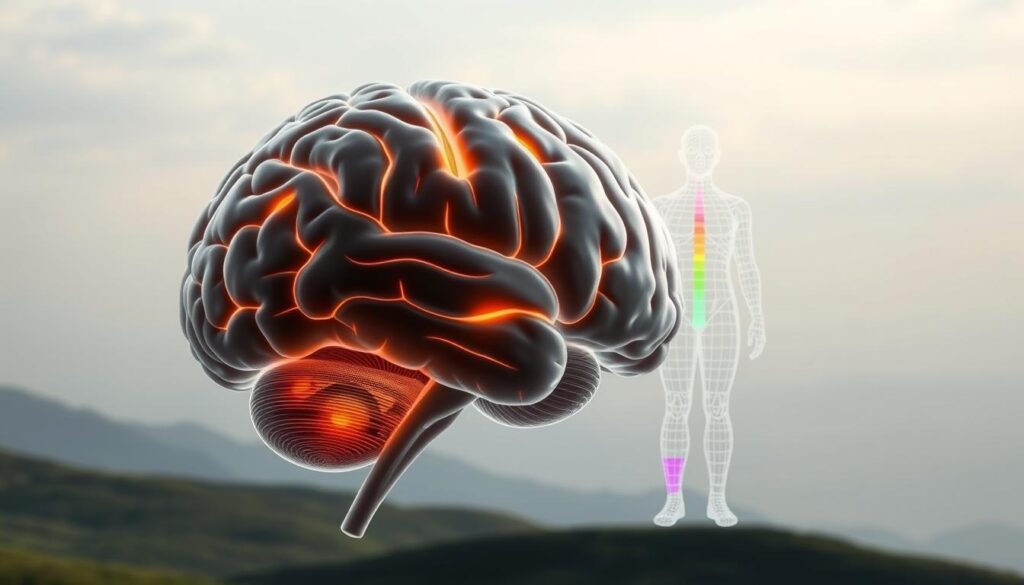Can changing what you eat actually rewire how your brain values food and controls memory? This article examines that question using imaging studies metabolic data and clinical trials.
Weight loss is linked to brain cells. Recent resting-state and task fMRI work shows that multi week dietary changes lower activity in the insula orbitofrontal cortex, and frontal gyri in adults with obesity while short fasts do not produce the same widespread signal shifts.
We summarize how leptin, glucose, and insulin respond across interventions, why hippocampal activity and episodic memory can improve after dieting in older adults, and why some nutrient specific responses stay blunted after meaningful weight reduction.
Read on to learn how imaging quantifies neural changes, which regions govern food choice and interoception, and what these findings mean for long term body weight control and clinical practice.
Key Takeaways
- Multi week calorie restriction lowers activity in salience and executive networks and reduces leptin and glucose levels.
- Short-term fasting alters insulin differently and does not mirror diet-induced brain changes in obesity.
- Hippocampal activity and memory may improve after dietary interventions in older adults.
- Nutrient-specific cerebral responses often remain impaired in obesity, even after ~10% reduction.
- Study design, participant selection, and data quality matter use google scholar to vet any article’s methods.
Understanding why weight loss is linked to brain cells
Understanding how homeostatic and hedonic systems interact helps explain why some interventions change eating behavior over weeks rather than hours.
Homeostatic vs. hedonic control of eating behavior
Homeostatic control is the hypothalamic brainstem network that monitors internal energy hormones, and metabolic cues.
Hedonic and executive circuits then add reward value and decision control. These systems can drive food seeking even without an energy deficit.
When hedonic signals predominate, attention and valuation bias toward palatable items. That shift can promote obesity by raising activity in reward and salience networks.
From brain activity to food intake: the present state of science
Imaging studies show higher activity and connectivity in the hypothalamus insula cingulate, and OFC in many adults with obesity.
Repeated high calorie intake appears to entrain those networks, making behavioral change harder and altering actual food intake over time.
Multi week dietary interventions change hormonal profiles leptin, insulin, glucose and, over weeks, can reduce reward-region signal and functional connectivity in some participants.
- Evaluate any study or article by design, sample, and methods in Google Scholar before drawing clinical conclusions.
How scientists measure brain changes magnetic resonance imaging and beyond
Magnetic resonance imaging lets researchers track neural responses by measuring blood-oxygen shifts and network coupling. The primary hemodynamic marker is the BOLD signal which reflects local oxygenation linked to neural activity and short-term response.
Functional MRI BOLD and connectivity
Resting state fMRI maps intrinsic connectivity across networks like salience and executive control. Seed and dual-regression analyses quantify coupling between regions such as the amygdala and hypothalamus.
Resting-state versus task-based approaches
Task-based scans capture stimulus-evoked activity. For example, a face-name memory paradigm analyzed with SPM8 showed increased anterior hippocampal activity after intervention during encoding.
Regions of interest and quality controls
Common ROIs include hypothalamus homeostatic control insula interoception OFC food valuation , and hippocampus memory .
Robust preprocessing motion correction CSF normalization, smoothing, and permutation testing with TFCE and FWE helps ensure reliable voxel wise comparisons across participants.
- Compare before and after scans to attribute effects to an intervention.
- Correlate insulin, glucose, and hormone levels with BOLD and connectivity for energy related interpretation.
- Use google scholar to vet the article author methods scanner parameters, and participant selection.
You may like to read: Gut Healthy and Sustainable Eating Guide
Obesity and the brain altered functional connectivity and activation patterns
Cross-sectional imaging frequently shows that people with obesity have stronger neural responses when exposed to food cues.
The pattern includes elevated signal in salience regions, sensory motor areas, and executive control networks. Regions commonly implicated are the hypothalamus insula cingulate, and orbitofrontal cortex OFC .
Elevated signal in salience sensory motor and executive control networks
Higher activity in these systems boosts attention and motor readiness toward rewarding items. The OFC assigns higher value to palatable energy dense options biasing choices.
Increased insula activation can magnify interoceptive awareness of hunger and craving. That state strengthens responses to external food cues and makes self-control harder.
What increased activity means for reward processing and food cues
Higher regional activity and stronger connectivity both appear in many cross sectional reports, but they are distinct metrics.
Some interventions show reduced BOLD signal in key regions without parallel changes in functional connectivity. This divergence suggests different neural adaptation paths after behavioral change.
- Practical note: Read each article’s methods and use google scholar to check scan parameters and sample size.
- Behavioral implication: Stronger cue responses prime approach and intake, reinforcing habits that challenge long term management.
| Feature | Common finding in obesity | Intervention outcome selected studies |
|---|---|---|
| OFC activation | Elevated valuation signal for palatable food | BOLD often decreases after sustained change |
| Insula activity | Higher interoceptive/craving responses | Activity may fall, but craving signals can persist |
| Functional connectivity | Often higher coupling within salience networks | Connectivity sometimes remains stable despite lower regional signal |
What changes with sustained weight loss insights from resonance imaging
Sustained reductions in intake produce measurable shifts in resting neural signals within valuation and interoceptive regions.
Decreased BOLD signal in the insula orbitofrontal cortex, and frontal gyri
In an 8-week, ~600 kcal/day intervention, magnetic resonance imaging revealed FWE corrected reductions in BOLD signal in the OFC, insula, and frontal gyri. These drops indicate lower regional activity in circuits that govern valuation and interoception during rest.
Lower frontal gyri activation suggests recalibration of executive processes. That change may reduce reactivity to food cues and support sustained behavioral change during dietary programs.

Functional connectivity stability despite intervention
Despite clear regional signal decreases, network connectivity default mode, salience, executive control remained stable in this study. This suggests coupling across networks can be more resistant or slower to change than local activation.
Higher leptin and higher BMI correlated with greater baseline and post-diet signal in valuation areas, linking adiposity related levels and regional activation. A 48-hour fast did not produce voxel wise reductions, highlighting a difference between short deprivation and sustained change.
- Magnetic resonance and careful FWE corrected analysis detect small-sample effects when design is rigorous.
- Consider both activity and connectivity endpoints when evaluating progress they can diverge.
Memory and the hippocampus cognitive benefits after dietary weight loss
In older adults, modest reductions in body mass can produce clear cognitive gains. A controlled article reported better episodic recall and stronger encoding signals in the hippocampus after a multi-week dietary program in postmenopausal participants.
Improved episodic memory and hippocampal activation
The study of 20 overweight obese women showed recall rising from 16.7 ± 3.3 to 18.5 ± 2.0 correct face-name pairs (p=0.010). Right anterior hippocampal activity during encoding increased alongside better scores.
Metabolic links and clinical implications
Plasma free fatty acid levels fell, and waist circumference reductions correlated with frontal and temporal activation changes. Plasma glucose and insulin stayed similar suggesting lipid shifts drove the effect.
- The hippocampus supports memory consolidation its activation is sensitive to energy and dietary composition.
- Both modified Paleolithic and Nordic style groups had similar outcomes highlighting adherence and energy balance over specific menus.
- Clinicians should consider memory as a patient centered outcome when evaluating interventions.
| Measure | Baseline | Post-intervention |
|---|---|---|
| Episodic recall face-name pairs | 16.7 ± 3.3 | 18.5 ± 2.0 (p=0.010) |
| Anterior hippocampal activity | Lower | Increased during encoding |
| Plasma free fatty acids | Higher | Decreased |
| Plasma glucose / insulin | No significant change | No significant change |
Post ingestive nutrient signaling and dopamine what the latest study shows
Bypassing taste revealed how the gut informs reward systems. Direct intragastric infusions of glucose and lipids produced clear nutrient-specific brain responses in lean adults.
Nutrient specific brain responses in lean participants
In 30 lean participants, glucose and lipid infusions caused distinct cerebral BOLD changes and triggered striatal dopamine release.
Key point: these effects occurred without orosensory cues, showing the gut brain axis conveys macronutrient identity to central reward circuits.
Severely impaired responses in obesity and partial non reversal after weight loss
In 30 adults with obesity, the same infusions produced markedly blunted signal changes and much less dopamine release.
Crucially, approximately 10% dietary reduction did not restore these neuronal responses, suggesting durable alterations in nutrient signaling pathways in obese individuals.
The randomized, controlled, crossover design isolates post-ingestive mechanisms and reduces taste or expectancy bias.
- GLP-1 release with lipids correlated with striatal BOLD only in lean participants, pointing to a therapeutic target.
- Convergent endpoints BOLD, dopamine, hormones support the conclusion that obesity impairs nutrient specific signaling.
- Clinicians should read each article’s author methods and use google scholar to assess imaging and endocrine endpoints before generalizing.
| Endpoint | Lean group | Obese group |
|---|---|---|
| Striatal dopamine | Robust release with nutrients | Blunted release |
| BOLD signal nutrient-specific | Distinct glucose vs lipid changes | Reduced, non-specific changes |
| GLP-1 correlation | Strong with lipids | Absent |
Leptin insulin glucose metabolic signals that shape brain responses
Circulating hormones play a central role in tuning valuation and interoceptive circuits during different metabolic states.
Leptin showed robust positive correlations with BOLD activity in valuation and interoceptive regions.
For example baseline OFC activity correlated with leptin (r=0.625, p=0.017) and insula activity also tracked leptin (r=0.590, p=0.026). These links imply that adiposity-associated hormonal levels modulate regional neural signal and may reinforce heightened valuation in higher BMI participants.
Insulin and glucose dynamics fasting versus sustained change
Insulin fell sharply after a 48-hour fast but did not decline after the multi week intervention, while glucose decreased in both conditions. This pattern shows distinct metabolic states produce different neural responses.
Clinical and research implications
Correlations do not prove causation, but they guide hypotheses. Use magnetic resonance imaging and imaging endpoints alongside metabolic measures when you read any article, and check methods in google scholar to judge quality.
Improved metabolic flexibility, not only reduced energy intake, may better align activity and connectivity with beneficial effects over time.
Body mass index and body weight structural and functional ties to the brain
Higher body mass often maps onto stronger neural responses in reward and control regions that guide eating choices.
Correlations between BMI and activity in executive and reward regions
Imaging studies show that body mass index and body weight correlate with greater activation in the orbitofrontal cortex and frontal gyri.
These correlations appear in both task and resting scans of participants. Elevated mass index often predicts higher valuation signals and attention toward palatable food.

Cross-sectional articles also report structural and connectivity differences linked with body mass. Higher adiposity can associate with altered white matter and stronger coupling in reward networks.
Why this matters: reductions in body mass sometimes coincide with lower BOLD signal in valuation areas. That change may reflect partial normalization of heightened reward sensitivity before larger behavioral shifts follow.
Small differences in mass index can correspond to meaningful shifts in cognitive control over food.
- Pair BMI with neural activity markers to assess progress beyond the scale.
- Read each study’s methods in google scholar to judge imaging quality and participant selection.
- Follow up with connectivity analyses to see if network-level adaptations accompany changes in mass index over time.
| Measure | Typical finding | Implication |
|---|---|---|
| OFC activation | Higher with greater body mass | Elevated valuation of palatable food |
| Frontal gyri activity | Positive correlation with BMI | Altered executive control and attention |
| Structural connectivity | White-matter differences reported | May support persistent reward bias |
| BOLD signal change after reduction | Often decreases | Early neural marker of behavioral shift |
Clinical note: Consider imaging endpoints in complex cases where progress stalls. Use google scholar to compare cohorts, scanners, and preprocessing before applying findings to care.
Short term fasting versus sustained weight loss different effects on the brain
An acute 48-hour fast alters hormones quickly, yet its neural footprint differs from sustained dietary programs.
In the referenced study, fasting produced a clear fall in insulin and small glucose shifts, but no significant voxel-wise BOLD changes appeared across valuation regions.
By contrast, an 8-week dietary reduction produced robust decreases in OFC, insula, and frontal gyri signal. Those regional changes emerged alongside gradual metabolic shifts rather than the abrupt insulin drop seen after fasting.
Why short deprivation is not a substitute for sustained change
Acute insulin reductions did not translate into widespread activity change. That suggests brief deprivation is insufficient to reshape core valuation circuits.
Longer interventions likely engage slow adaptations leptin modulation altered energy balance, and receptor or synapse level plasticity that adjust response properties in OFC and insula.
- Functional connectivity remained stable after both fast and program, so network coupling may need longer or different stimuli to shift.
- Cravings and food intake often rebound after fasting, while sustained programs can steadily lower cue-reactivity.
Imaging endpoints give objective differentiation between short-term metabolic effects and durable neural recalibration.
Clinicians should treat fasting as a metabolic tool, not a stand-in for the brain recalibrations seen with prolonged change. Use google scholar to compare articles that directly contrast fasting and sustained interventions in participants with obesity.
Older adults and obese individuals: who benefits and how
Older adults can gain clear cognitive benefits from well supported dietary programs that also reduce central fat. Postmenopausal women in a controlled study showed better episodic recall after six months, alongside metabolic shifts.
Cognitive outcomes in postmenopausal women
The article reported that participants classified as overweight obese improved face‑name recall. At the same time, anterior hippocampal activity rose during encoding.
This co‑occurrence suggests a functional gain in neural efficiency or an improved signal‑to‑noise ratio in memory circuits.
- Body and metabolic correlates: reductions in waist circumference and plasma free fatty acids tracked with hippocampal gains.
- Diet type mattered less: benefits appeared across different dietary patterns, highlighting adherence and overall energy balance.
- Clinical advice: clinicians should monitor cognitive endpoints in obese individuals early memory wins can boost motivation and quality of life.
Track participant selection and methodology carefully generalizability depends on cohort age and health status.
While some nutrient‑specific responses remain blunted in obesity, memory related activity can still improve with focused programs and structured support.
Before applying findings, use google scholar to review each article’s methods, and consider group sessions, education, and monitoring to help older adults convert neural gains into daily behavior.
Main keyword focus Weight loss is linked to brain cells
Dietary reductions produce measurable shifts in resting neural signals across valuation, interoceptive, and memory networks.
What the data show: sustained reductions in intake lower resting state BOLD in the orbitofrontal cortex and insula and can raise hippocampal encoding activity. These changes track with leptin and mass index, while insulin and glucose follow different time courses depending on fasting versus multi week programs.
Not all responses normalize. Post-ingestive, dopamine-related signaling often stays blunted after modest loss and may need longer or adjunctive therapies to recover.
Practical takeaway: combine dietary adherence, behavioral control strategies, and when appropriate, pharmacologic support to recalibrate functional brain circuits. Use magnetic resonance imaging and resonance imaging endpoints to measure activation and connectivity as objective markers of progress.
- Track hormones leptin, insulin, glucose alongside imaging and clinical outcomes.
- Compare control conditions fasting vs sustained change when reading any study.
- Use google scholar to vet article methods, data pipelines, and participant selection before applying results.
Incremental neural and behavioral gains can accumulate with continued engagement and targeted support.
From laboratory signals to everyday choices translating findings into action
Bridge lab results and routine behavior by favoring steady achievable changes that reshape valuation and memory circuits over weeks.

Diet composition, energy balance, and functional outcomes
Prioritize sustainable energy deficits rather than brief restriction. Multi-week reductions that improve lipid profiles higher MUFA/PUFA often coincide with better memory and lower OFC and insula activity.
Behavioral strategies to align hedonic and homeostatic drives
Use cue management, structured meal timing, and stimulus control to lower craving driven food intake and support executive control.
- Track hunger, craving, and performance alongside weight and waist measures to guide adjustments.
- Plan recovery steps after lapses to prevent rebounds driven by heightened valuation signals.
- Combine sleep hygiene and cognitive training to strengthen connectivity for self control.
Work with clinicians and use google scholar to interpret any article or study and tailor plans for participants.
Practical note: start small, monitor proxies for leptin adiposity, and lean on group or coach support when neural responses lag behind behavioral change.
You may like to read: The Best Way to Lose Weight
Key brain regions to know: OFC insula, hippocampus, hypothalamus
Four regions anchor how cues, internal states, memory, and hormones shape eating choices. Below we define each region and what imaging studies report after sustained change.
OFC and food valuation
The orbitofrontal cortex assigns value to rewards and guides choice. Decreased activation in the OFC after multi-week programs often reduces the pull of high reward items.
This change appears as lower BOLD signal and can make tempting foods less salient during decision moments.
Insula and interoception
The insula maps hunger fullness, and visceral feelings. Lower resting-state signal in this region after interventions may dampen cravings and visceral urges.
That reduction supports clearer decision making when external cues appear.
Hippocampus and memory guided eating
The hippocampus links context past outcomes, and planning during meals. Stronger hippocampal activity during encoding helps people recall recent meals and resist cue driven choices.
Imaging articles report improved recall and higher encoding activity in older participants after sustained programs.
Hypothalamus and connectivity: the hypothalamus integrates hormones and nutrient signals to modulate intake. Connectivity among OFC insula hippocampus, and executive areas determines real-time choices, and multi week interventions tend to rebalance activation and network coupling over time.
- Expect region-specific timing: hippocampal gains may appear earlier than full valuation shifts.
- Read each article’s ROI definitions and metrics in google scholar to judge methods and generalizability.
- Practical tip: use meal timing, cue avoidance, and mindful eating to leverage reduced valuation signals in daily life.
Research methods matter: datasets controls and how to read the data
Good conclusions start with solid methods. Studies that claim neural change after dietary interventions differ widely in design, preprocessing, and statistical rigor. Recognizing those differences helps you judge how much confidence to place in any single article.
Resting-state versus task paradigms
Resting-state analyses map intrinsic connectivity and often use FSL with ICA templates and dual regression. These pipelines reveal network coupling but do not show stimulus-evoked encoding.
Task-based scans for example, memory encoding use packages such as SPM8 and capture region-specific activation during defined tasks. Use both types for a fuller picture: connectivity and activation answer related but distinct questions about neural adaptation.
Control conditions and isolating effects
Look for clear control arms: fasting baselines, intragastric water infusions, or baseline task runs. Crossover designs and randomized groups reduce bias and help isolate post‑ingestive versus expectancy effects.
Data quality markers and evaluation checklist
Credible author teams report motion correction CSF normalization permutation inference with TFCE and FWE, and open code or data links. Small samples need rigorous correction and transparent ROI definitions.
- Use google scholar to check replication, preregistration, and prior work by the same author.
- Verify clear endpoints, sample size justification, and whether magnetic resonance imaging parameters are reported.
- Confirm whether activity and connectivity metrics align with clinical measures such as metabolic readouts or weight trajectories.
Assess methods first robust preprocessing and control conditions turn noisy datasets into actionable insights.
Quick checklist for reading any study: replication status on google scholar preregistration, transparent preprocessing well‑matched groups, and shared code or data. Triangulate findings across articles before changing practice.
Limitations and open questions in the present evidence
Clear gaps remain: current articles show regional activity changes after interventions, but they cannot always determine cause versus consequence in obesity related alterations.
Cause versus consequence
Cross-sectional designs cannot prove whether higher valuation drives overeating or results from prolonged exposure to energy-dense diets and excess adiposity. Longitudinal cohorts that track neural signals and behavior across weight cycles are needed.
Why some neuronal responses persist
Nutrient specific reward responses demonstrated by intragastric infusion studies often remain blunted after ~10% reduction. That persistence complicates maintenance and suggests partial adaptation rather than full normalization.
Methodological limits also matter: small samples varied tasks, and short follow-up reduce generalizability. Notably several studies report reduced regional BOLD signal without matching changes in connectivity raising questions about sequence and durability of neural adaptation.
- Participant heterogeneity baseline hormones adiposity alters effect sizes.
- Future work should combine diet targeted pharmacologic supports, and longer follow up.
- Use google scholar to find replications, meta-analyses, and standardized protocols before generalizing any study.
Conclusion
Conclusion
Sustained dietary change produces measurable shifts: lower valuation and interoceptive signals in the OFC and insula, and improved hippocampus activation and memory in older participants.
Some nutrient specific responses remain impaired after modest loss, so realistic expectations and adjunct therapies may be needed. Track metabolic levels leptin, insulin, and glucose alongside imaging and behavior to tailor programs for participants.
Connectivity changes often lag behind regional activation, so longer follow-up and multimodal measures help clarify durable effects. Read each article’s methods in google scholar before applying findings, and combine structured diet behavioral strategies, and, when appropriate, pharmacologic support to align food choices and long-term brain resilience.
You may like to read: How to Lose 5kg in 7 Days A Simple Diet Plan.





